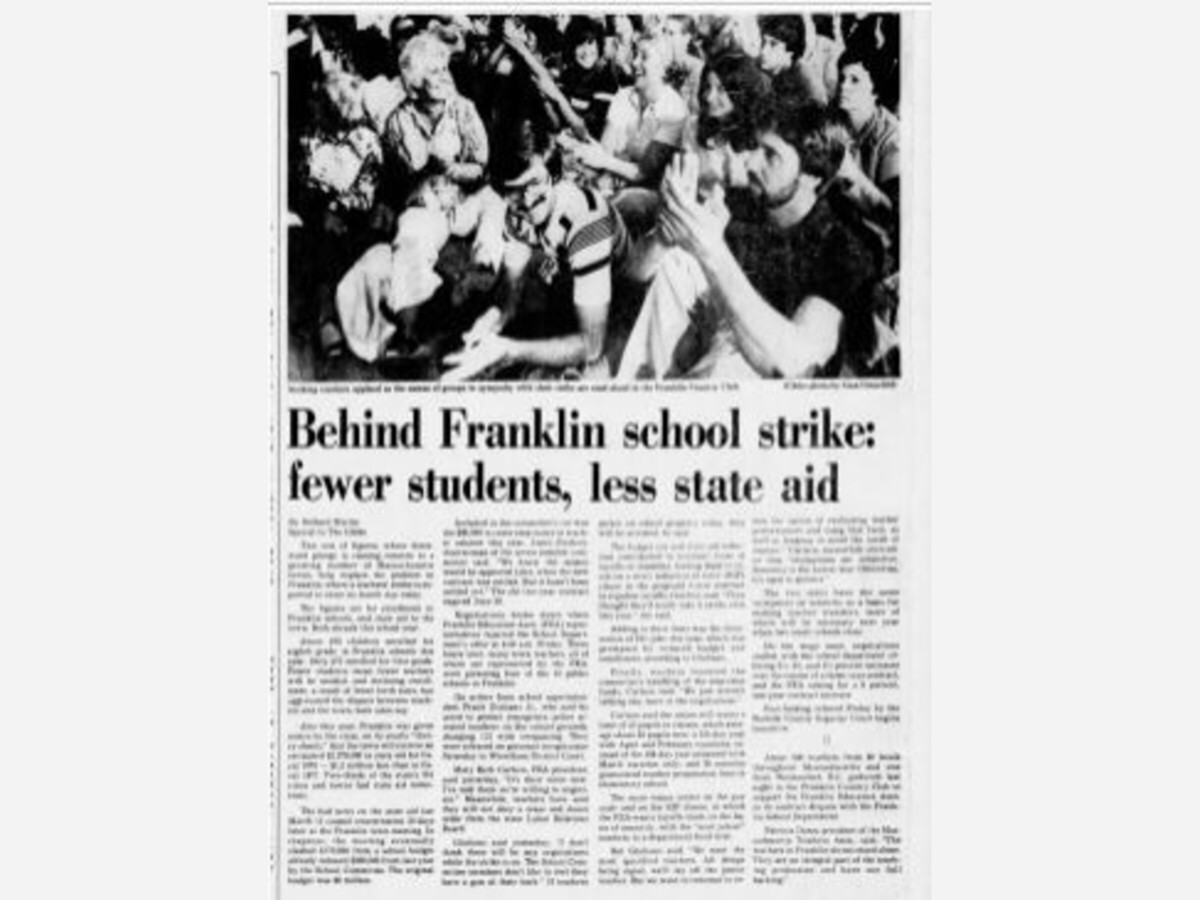Image

Besides a few minor disturbances in the mills at the turn of the 20th century, Franklin had witnessed very little sustained discontent or turmoil as a result of labor problems for most of its history – until the Great Teachers’ Strike of 1977. It was an event that drew national attention to the town and produced long-lasting divisions.
By the late 1970s, there were rumblings of disquiet coming from the teachers in the Franklin school system. There were mounting concerns about pay, seniority, and maternity leave and about rowdy, violent students. Members of the class of ’78 streaked through the high school library—nude—at least once, and yearbooks from the ‘70s are filled with pictures of students fisting beers in the parking lot (the legal drinking age was 18 at the time). And one police officer was clubbed on the head with a brick by a student, while trying to break up a fight.
Like most states at the time, Massachusetts forbid teachers and other government employees from going on strike. But, in September 1977, Franklin students returned from summer break only to find, a few days after Labor Day, that Franklin teachers decided, overwhelmingly, to go on strike.
Some former teachers claim that at the time, the Massachusetts Teacher’s Association was applying quiet pressure, floating Franklin teachers up as a ‘test balloon’ to see how the state would respond to a strike. In any case, it would be a painful experience.
The strike involved every teacher to some degree. Many, joined the strike not because of any deep conviction, but because they wanted to support their coworkers. Out of the 286 teachers in the school system, almost all participated in the strike. There were a few who stayed at work, but they constituted a tiny minority. And in the years after the strike, there was plenty of animosity between the teachers who went on strike, and those few who did not.
Striking teachers picketed and marched outside the schools. For most of the month of September, schools were open, staffed with a few fulltime teachers and as many substitutes as the School Committee could find. For weeks, only 75 percent of students attended school, and some only turned up for their homeroom classes, to be marked “present” in the roster. Parents were worried, many choosing to keep their kids home rather than sending them to school amidst the strife.
Regardless, the School Committee took a firm stance against the strikers, insisting that they return to work or face losing their jobs. The strikers ignored the warnings and chose to continue the strike. The School Committee decided that enough was enough. Police officers and deputy sheriffs arrived at the high school and middle school, arresting 34 teachers in a single day.
Hauled off in police vans, the first batch of strikers appeared at court in Dedham where they were promptly sentenced to time in county jail. The Franklin School Committee and the Norfolk County courts hoped that a stern message had been sent to the strikers--call off the strike, or else. Even so, most teachers were still on strike. A week after the first group had gone to the ‘slammer,’ an astonishing 100 teachers were rounded up and arrested by the police. Appearing before Judge Greaney in Dedham, the teachers were fined $950 each (equivalent to several thousand dollars, today), and sentenced to jail for the roles they played. “I hope you don’t confuse what you are doing with the great acts of civil disobedience that led to the creation of this country,” Greaney said to the assembled teachers.
The courts acted fast, sentencing the strikers in large groups of up to 30 at a time. Some teachers grinned defiantly while others wept uncontrollably as Greaney handed down indefinite sentences for contempt of court charges. The court had backed up the Franklin School Committee, ordering the teachers to return to work.
Some Franklin teachers were sentenced to county jails, but others landed in state prisons. Female teachers ended up at the women’s penitentiary in Framingham, while male teachers ended up sharing cells and meals with murderers and rapists. According to Judge Larry Parnell, who took part in sentencing, “We’re putting them wherever there is floor space.” The 14 female teachers sent to Framingham ended up staying in the prison hospital--there were no cells left any place else.
The remaining 180 teachers were told to end the 14-day strike, or they would all be rounded up and sentenced, per order of Judge Greaney. The School Committee offered its own solution, in the form of a new contract proposal. Meeting at the Franklin Country Club, only 3 teachers supported the new school contract. With nothing left to sacrifice, the jailed teachers voted over the telephone, rejecting the proposal. Despite their rejection of the proposal, Greaney stood firm with the county sheriff and local police to back him up.
Realizing that they had lost, the remaining strikers agreed to negotiate an end the strike by October 1, 1977.
On October 1, the great Franklin teacher’s strike came to an end. The teachers returned to work, bitterly in some cases, for very little had changed. Over the coming days, the teachers in county jail and state prisons were let out, but release was hardly satisfying.
And, in one case, a female teacher who had been trying to have a baby for years, reportedly miscarried during her incarceration.
Franklin teachers had been defeated, sacrificed, some felt, in an experiment encouraged by the state union, and now the Franklin Education Association had to pay $150,000 in fines. Additionally, each teacher had to pay their own $950 fine unless they wanted to go back to jail.
Adapted from the book, Franklin: From Puritan Precinct to 21st Century 'Edge City', by Eamon McCarthy Earls, copyright 2012, available at Amazon.com